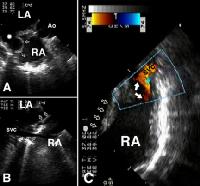Atrial septal defect sinus venosus
|
Atrial Septal Defect Microchapters | |
|
Treatment | |
|---|---|
|
Surgery | |
|
| |
|
Special Scenarios | |
|
Case Studies | |
|
Atrial septal defect sinus venosus On the Web | |
|
American Roentgen Ray Society Images of Atrial septal defect sinus venosus | |
|
Risk calculators and risk factors for Atrial septal defect sinus venosus | |
Editor-In-Chief: C. Michael Gibson, M.S., M.D. [1]; Associate Editor(s)-In-Chief: Priyamvada Singh, M.B.B.S. [2]; Cafer Zorkun, M.D., Ph.D. [3] Assistant Editor(s)-In-Chief: Kristin Feeney, B.S. [4]
Overview
During fetal development, the septal wall may fail to fuse causing an atrial septal defect to arise. A sinus venosus atrial septal defect is one such type of malformation arising from the irregular development of the septum and the superior vena cava or the inferior vena cava.
Pathophysiology
1) Sinus venosus ASD is commonly found to be associated with partial anomalous pulmonary venous return.
2) In the presence of partial anomalous pulmonary venous return (pulmonary veins draining into the right atrium instead of the left atrium), atrial septal defect should be corrected by placement of patch over the defect. In larger defects, it is essential to ensure the usage of a synthetic patch to be placed strategically, to allow anomalous pulmonary venous drainage, to be diverted to the left atrium.
3) In this case, anomalous pulmonary venous drainage must be carefully monitored and assessed as compromise of pulmonary venous return due to redirection could lead to pulmonary venous hypertension.
Natural History, Complications and Prognosis
1) Good post-surgical prognosis irrespective of the patient's age at surgery.
2) Surgery for sinus venosus ASD is complex compared to other atrial septal defect and can cause stenosis of the superior vena cava or pulmonary veins, residual shunting and SA node dysfunction.
Diagnosis
Echocardiography
Echocardiography is the preferred diagnostic tool in the evaluation of an atrial septal defect. Out of the different types of echocardiographic modalities that can be used, transesophageal echocardiography can be used for all types of atrial septal defects. Trials have shown transesophageal echocardiography to be superior in diagnosing sinus venosus ASD compared to transthoracic echocardiography.[1][2] Sinus venosus atrial septal defect has posterior location. Due to this, transesophageal echocardiography (TEE) becomes more suitable for diagnosing it because of the proximity of the transducer to the defect. [3]
Studies have found transesophageal echocardiography to be superior in diagnosing sinus venosus ASD compared to transthoracic echocardiography.[1] [2]
An sinus venosus defect can be identified on an echocardiogram in many ways.
- A subcostal 4 chamber view by paying special attention to the superior and posterior portions of the atria.
- Can be visualized at the top of the septum near the insertion of the superior vena cava where it occurs.
- If echo shows right ventricle overload and no ASD, consider anomalous pulmonary vein.
{{#ev:youtube|dA2Zjq4Cx20}}
Coronary Sinus Atrial Septal Defect Parastermal Long Axis View
{{#ev:youtube|7wUKFnyU_HA}}
Unroofed coronary sinus atrial septal defect 2D and 3D Echo
References
- ↑ 1.0 1.1 Kronzon I, Tunick PA, Freedberg RS, Trehan N, Rosenzweig BP, Schwinger ME (1991). "Transesophageal echocardiography is superior to transthoracic echocardiography in the diagnosis of sinus venosus atrial septal defect". J Am Coll Cardiol. 17 (2): 537–42. PMID 1991912.
- ↑ 2.0 2.1 Mehta RH, Helmcke F, Nanda NC, Pinheiro L, Samdarshi TE, Shah VK (1991). "Uses and limitations of transthoracic echocardiography in the assessment of atrial septal defect in the adult". Am J Cardiol. 67 (4): 288–94. PMID 1990793.
- ↑ Pascoe RD, Oh JK, Warnes CA, Danielson GK, Tajik AJ, Seward JB (1996). "Diagnosis of sinus venosus atrial septal defect with transesophageal echocardiography". Circulation. 94 (5): 1049–55. PMID 8790045.
